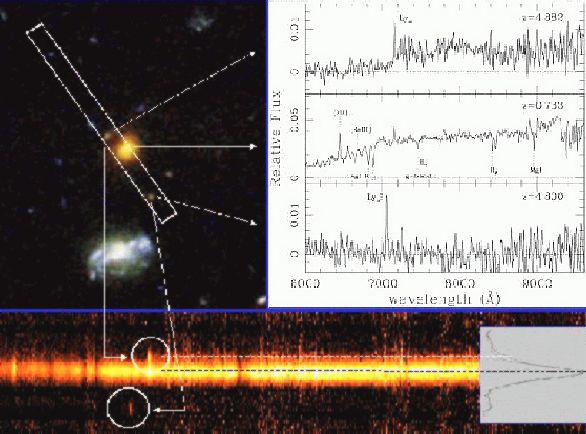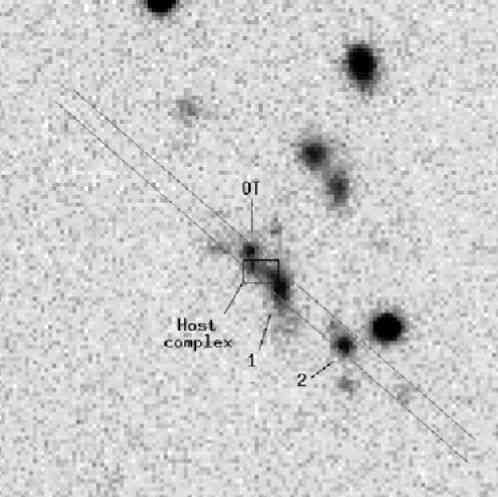
Halton C. Arp,
Max-Planck-Institut fьr Astrophysik,
Karl Schwarzschild-Str.1, Postfach 1317, D-85741 Garching, Germany,
Published here on May 29th, 2005 @ 16:00
arp@mpa-garching.mpg.de
In the Great Observatories Origins Deep Survey, 243 redshifts of objects fainter than 25.5 mag. were observed. Remarkably, two of them turned out to be very high redshift at z = 4.800 and z = 4.882. Even more remarkably these two fell only 3 and 1.5 arcsec on either side of an emisssion line galaxy of z = .733. (The ESO Messenger No. 118, p.49 and Vanzella et al. astro-ph/0406591.) The picture shown below is probably sufficient to convince most people that this is another pair of ejected, intrinsic redshift quasars.

Quasars of z = 4.882 and z = 4.800 are aligned across an emission line galaxy of z = .733. Emission Ly alpha can be seen intruding into the spectrum of the lower redshift, central galaxy. (Vanzella et al. astro-ph/0406591)
But if we compute once more the probability of the author’s redshifts falling this close to a given galaxy, alignment, similarity of redshifts etc. one gets 3.5 chances in 10 million of being accidental! This is hardly "a posteriori" since my Catalogue of Discordant Redshifts (Apeiron 2003) lists many similar pairs with even less probability of being chance. Then in the same Messenger issue on p.36 there is a GRB/Supernova of z = .691 connected to a host galaxy of z = .472. They hasten to inform us that the latter is a ”foreground galaxy” but as the picture below shows, there is a continuous luminous connection between the two. (Masetti et al. 2003, A&A 405, 465.)

OT (Optical Transient) is the after glow of a gamma ray burst. It has a redshift of z = .691 whereas the galaxies 1 and 2 have z = .472. (Masetti et al. 2003)
They do not reference the paper Geoffrey Burbidge publlshed titled "The Sources of Gamma-Ray Bursts and their Connections with QSO’s and Active Galaxies" (ApJ 2003, 585, 112.) Since, as usual, none of the above authors reference the voluminous evidence that quasars are intrinsically redshifted objects ejected from lower redshifted galaxies, there is very little chance of conventional astronomy correcting a huge error in their fundamental assumptions. The consequences for astronomy, and science in general, are discouraging to contemplate.
|
|